Article Review: Stroke Patient and Caregiver Rehabilitation Needs
VerifiedAdded on 2021/06/17
|8
|2012
|55
Report
AI Summary
This report provides a comprehensive review of an article by Ekstam et al. (2015) that examines the combined perceptions of stroke patients and their caregivers regarding rehabilitation needs one year after a stroke. The study employed a mixed-methods design, incorporating both quantitative and qualitative data collection through questionnaires and interviews. The research explored various factors, including stroke severity, caregiver burden, and the use of rehabilitation services. Key findings revealed that while a significant portion of patients and caregivers reported their rehabilitation needs were met, a considerable percentage indicated unmet needs, particularly among those with more severe strokes. The study highlights the importance of person-centered rehabilitation services and the development of effective coping strategies to reduce caregiver burden. The review also discusses barriers in implementation, such as the limitations in comparing the perceptions of partners within dyads, and emphasizes the need for a deeper understanding of the characteristics and expectations of both patients and caregivers to develop effective intervention plans. The report concludes by emphasizing the critical role of healthcare professionals and social workers in providing comprehensive care that addresses the needs of both patients and caregivers to improve quality of life and prevent adverse outcomes.
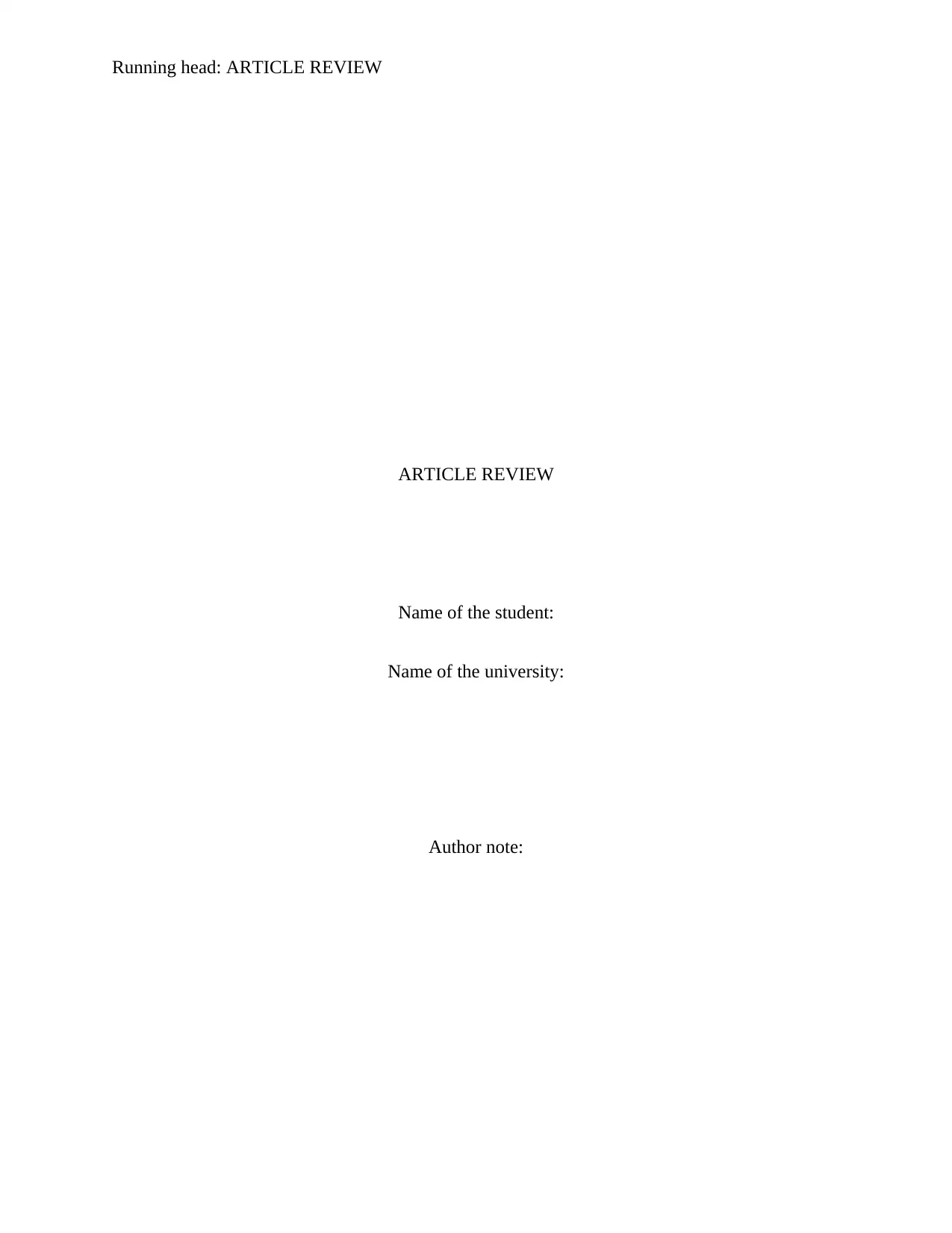
Running head: ARTICLE REVIEW
ARTICLE REVIEW
Name of the student:
Name of the university:
Author note:
ARTICLE REVIEW
Name of the student:
Name of the university:
Author note:
Paraphrase This Document
Need a fresh take? Get an instant paraphrase of this document with our AI Paraphraser
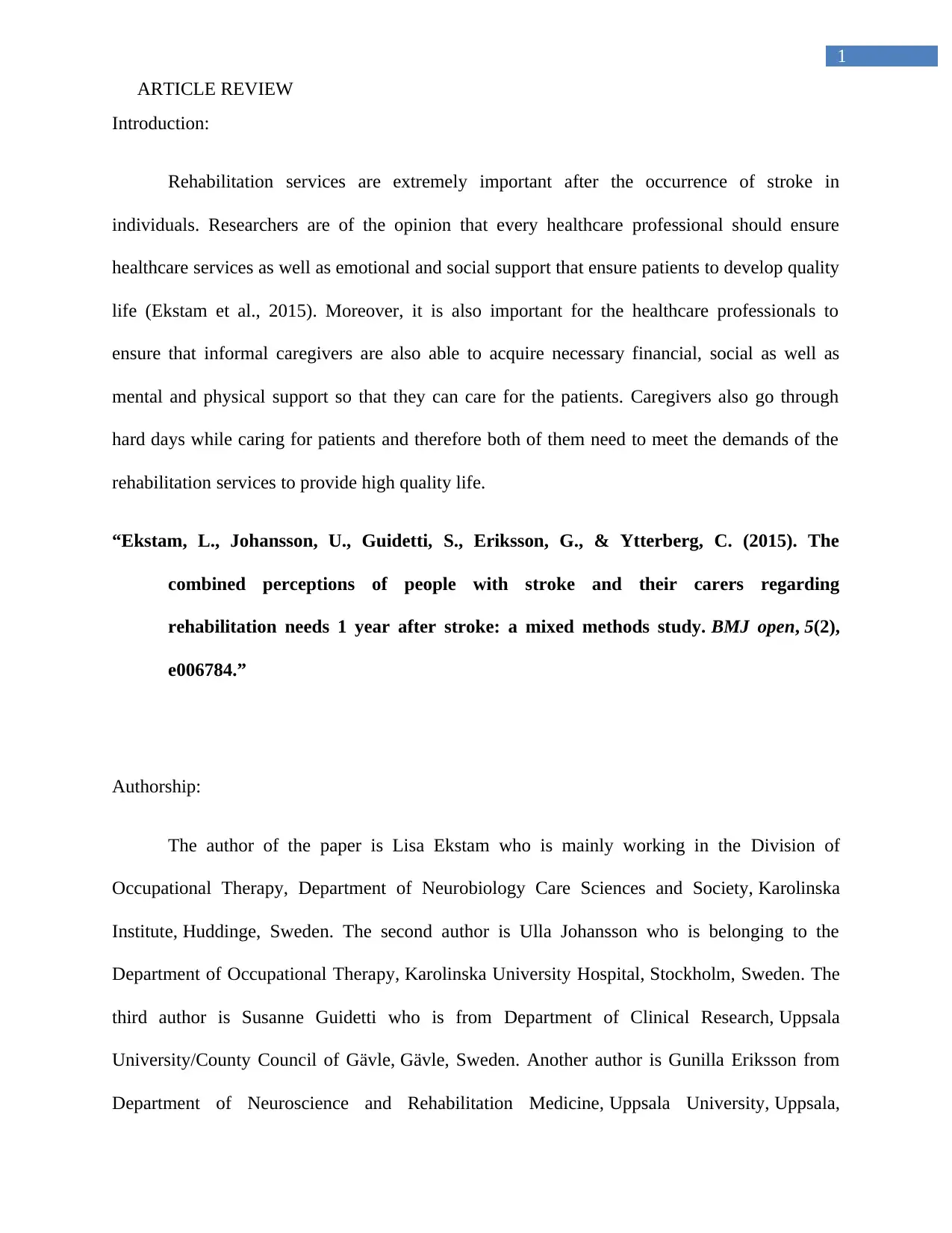
1
ARTICLE REVIEW
Introduction:
Rehabilitation services are extremely important after the occurrence of stroke in
individuals. Researchers are of the opinion that every healthcare professional should ensure
healthcare services as well as emotional and social support that ensure patients to develop quality
life (Ekstam et al., 2015). Moreover, it is also important for the healthcare professionals to
ensure that informal caregivers are also able to acquire necessary financial, social as well as
mental and physical support so that they can care for the patients. Caregivers also go through
hard days while caring for patients and therefore both of them need to meet the demands of the
rehabilitation services to provide high quality life.
“Ekstam, L., Johansson, U., Guidetti, S., Eriksson, G., & Ytterberg, C. (2015). The
combined perceptions of people with stroke and their carers regarding
rehabilitation needs 1 year after stroke: a mixed methods study. BMJ open, 5(2),
e006784.”
Authorship:
The author of the paper is Lisa Ekstam who is mainly working in the Division of
Occupational Therapy, Department of Neurobiology Care Sciences and Society, Karolinska
Institute, Huddinge, Sweden. The second author is Ulla Johansson who is belonging to the
Department of Occupational Therapy, Karolinska University Hospital, Stockholm, Sweden. The
third author is Susanne Guidetti who is from Department of Clinical Research, Uppsala
University/County Council of Gävle, Gävle, Sweden. Another author is Gunilla Eriksson from
Department of Neuroscience and Rehabilitation Medicine, Uppsala University, Uppsala,
ARTICLE REVIEW
Introduction:
Rehabilitation services are extremely important after the occurrence of stroke in
individuals. Researchers are of the opinion that every healthcare professional should ensure
healthcare services as well as emotional and social support that ensure patients to develop quality
life (Ekstam et al., 2015). Moreover, it is also important for the healthcare professionals to
ensure that informal caregivers are also able to acquire necessary financial, social as well as
mental and physical support so that they can care for the patients. Caregivers also go through
hard days while caring for patients and therefore both of them need to meet the demands of the
rehabilitation services to provide high quality life.
“Ekstam, L., Johansson, U., Guidetti, S., Eriksson, G., & Ytterberg, C. (2015). The
combined perceptions of people with stroke and their carers regarding
rehabilitation needs 1 year after stroke: a mixed methods study. BMJ open, 5(2),
e006784.”
Authorship:
The author of the paper is Lisa Ekstam who is mainly working in the Division of
Occupational Therapy, Department of Neurobiology Care Sciences and Society, Karolinska
Institute, Huddinge, Sweden. The second author is Ulla Johansson who is belonging to the
Department of Occupational Therapy, Karolinska University Hospital, Stockholm, Sweden. The
third author is Susanne Guidetti who is from Department of Clinical Research, Uppsala
University/County Council of Gävle, Gävle, Sweden. Another author is Gunilla Eriksson from
Department of Neuroscience and Rehabilitation Medicine, Uppsala University, Uppsala,
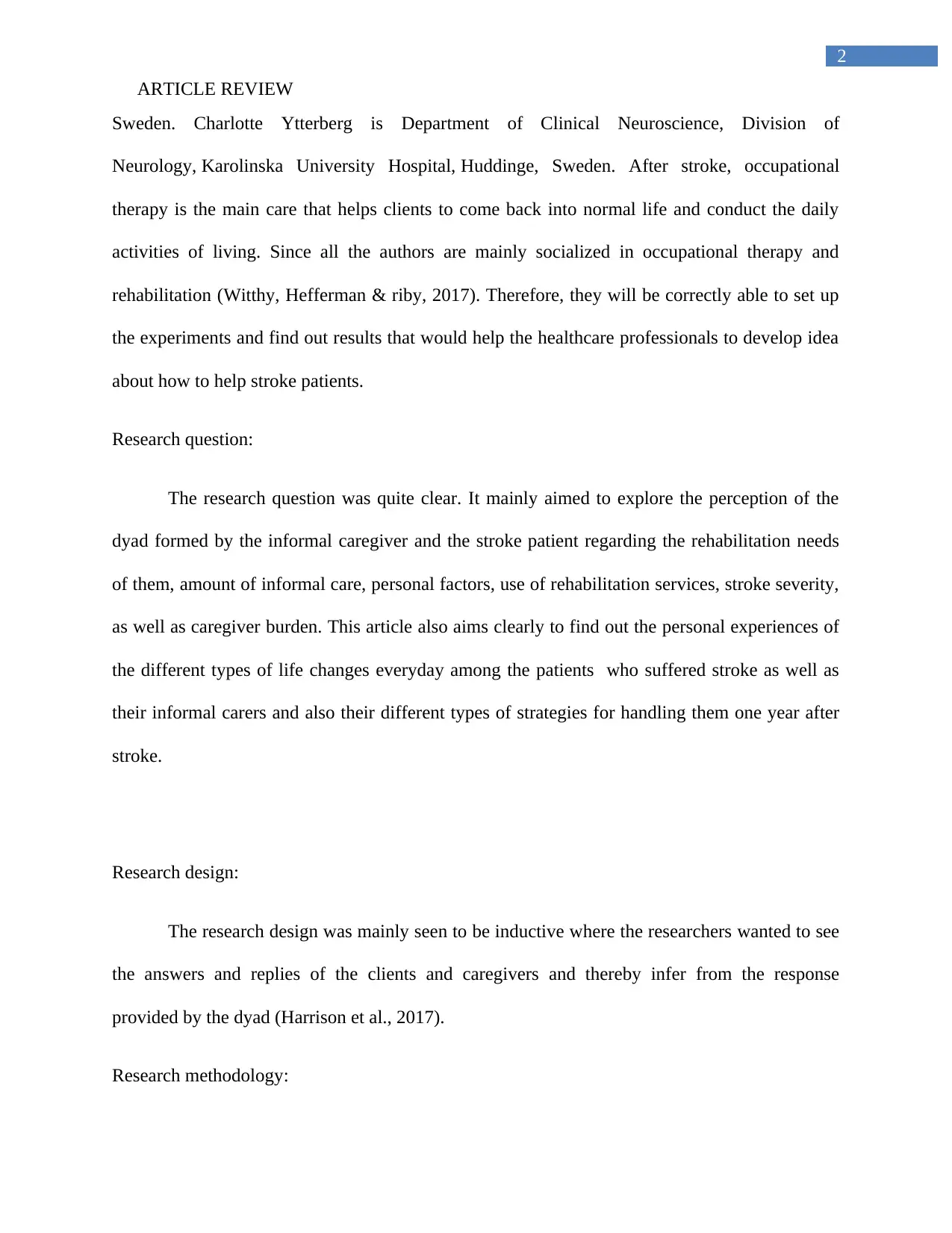
2
ARTICLE REVIEW
Sweden. Charlotte Ytterberg is Department of Clinical Neuroscience, Division of
Neurology, Karolinska University Hospital, Huddinge, Sweden. After stroke, occupational
therapy is the main care that helps clients to come back into normal life and conduct the daily
activities of living. Since all the authors are mainly socialized in occupational therapy and
rehabilitation (Witthy, Hefferman & riby, 2017). Therefore, they will be correctly able to set up
the experiments and find out results that would help the healthcare professionals to develop idea
about how to help stroke patients.
Research question:
The research question was quite clear. It mainly aimed to explore the perception of the
dyad formed by the informal caregiver and the stroke patient regarding the rehabilitation needs
of them, amount of informal care, personal factors, use of rehabilitation services, stroke severity,
as well as caregiver burden. This article also aims clearly to find out the personal experiences of
the different types of life changes everyday among the patients who suffered stroke as well as
their informal carers and also their different types of strategies for handling them one year after
stroke.
Research design:
The research design was mainly seen to be inductive where the researchers wanted to see
the answers and replies of the clients and caregivers and thereby infer from the response
provided by the dyad (Harrison et al., 2017).
Research methodology:
ARTICLE REVIEW
Sweden. Charlotte Ytterberg is Department of Clinical Neuroscience, Division of
Neurology, Karolinska University Hospital, Huddinge, Sweden. After stroke, occupational
therapy is the main care that helps clients to come back into normal life and conduct the daily
activities of living. Since all the authors are mainly socialized in occupational therapy and
rehabilitation (Witthy, Hefferman & riby, 2017). Therefore, they will be correctly able to set up
the experiments and find out results that would help the healthcare professionals to develop idea
about how to help stroke patients.
Research question:
The research question was quite clear. It mainly aimed to explore the perception of the
dyad formed by the informal caregiver and the stroke patient regarding the rehabilitation needs
of them, amount of informal care, personal factors, use of rehabilitation services, stroke severity,
as well as caregiver burden. This article also aims clearly to find out the personal experiences of
the different types of life changes everyday among the patients who suffered stroke as well as
their informal carers and also their different types of strategies for handling them one year after
stroke.
Research design:
The research design was mainly seen to be inductive where the researchers wanted to see
the answers and replies of the clients and caregivers and thereby infer from the response
provided by the dyad (Harrison et al., 2017).
Research methodology:
⊘ This is a preview!⊘
Do you want full access?
Subscribe today to unlock all pages.

Trusted by 1+ million students worldwide
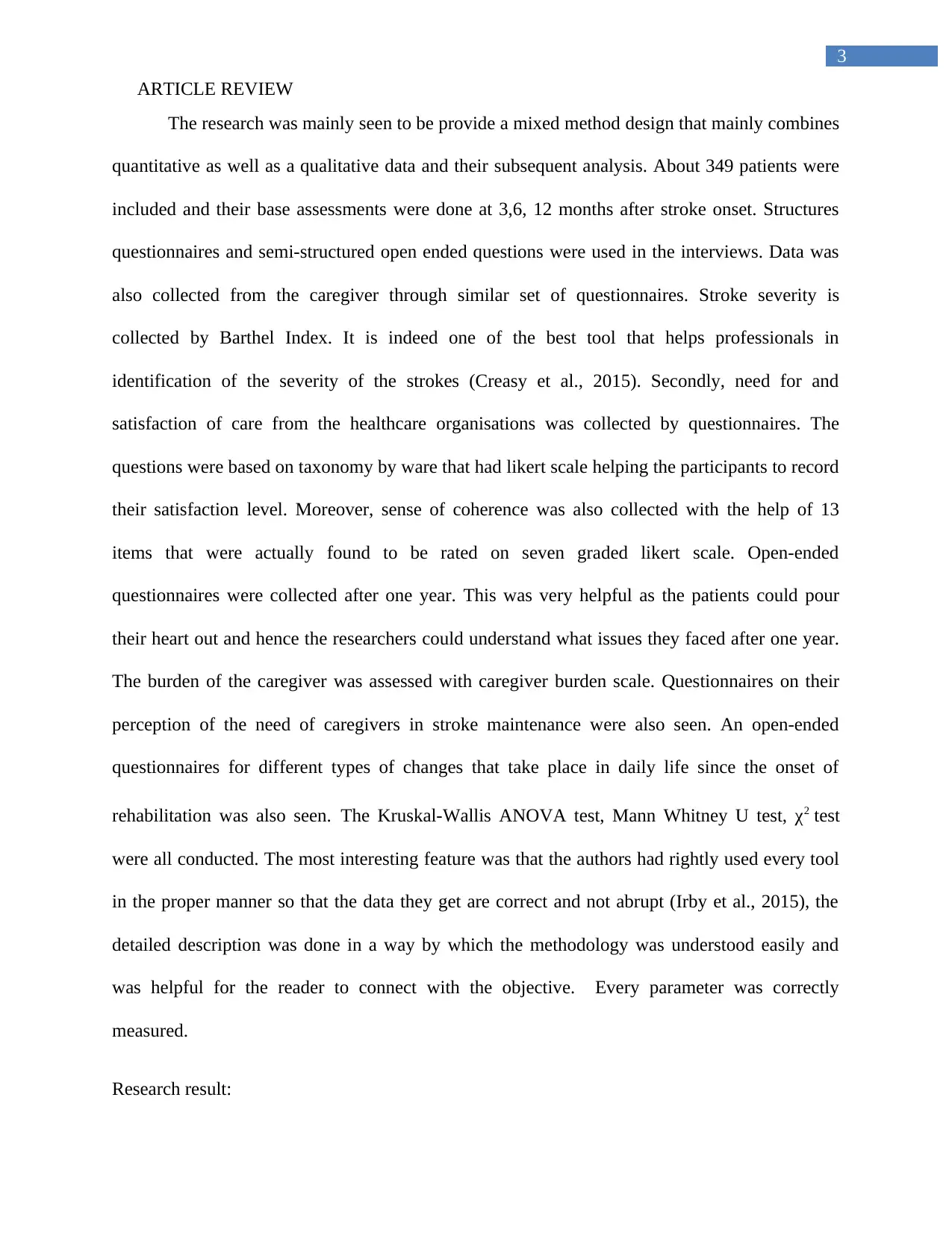
3
ARTICLE REVIEW
The research was mainly seen to be provide a mixed method design that mainly combines
quantitative as well as a qualitative data and their subsequent analysis. About 349 patients were
included and their base assessments were done at 3,6, 12 months after stroke onset. Structures
questionnaires and semi-structured open ended questions were used in the interviews. Data was
also collected from the caregiver through similar set of questionnaires. Stroke severity is
collected by Barthel Index. It is indeed one of the best tool that helps professionals in
identification of the severity of the strokes (Creasy et al., 2015). Secondly, need for and
satisfaction of care from the healthcare organisations was collected by questionnaires. The
questions were based on taxonomy by ware that had likert scale helping the participants to record
their satisfaction level. Moreover, sense of coherence was also collected with the help of 13
items that were actually found to be rated on seven graded likert scale. Open-ended
questionnaires were collected after one year. This was very helpful as the patients could pour
their heart out and hence the researchers could understand what issues they faced after one year.
The burden of the caregiver was assessed with caregiver burden scale. Questionnaires on their
perception of the need of caregivers in stroke maintenance were also seen. An open-ended
questionnaires for different types of changes that take place in daily life since the onset of
rehabilitation was also seen. The Kruskal-Wallis ANOVA test, Mann Whitney U test, χ2 test
were all conducted. The most interesting feature was that the authors had rightly used every tool
in the proper manner so that the data they get are correct and not abrupt (Irby et al., 2015), the
detailed description was done in a way by which the methodology was understood easily and
was helpful for the reader to connect with the objective. Every parameter was correctly
measured.
Research result:
ARTICLE REVIEW
The research was mainly seen to be provide a mixed method design that mainly combines
quantitative as well as a qualitative data and their subsequent analysis. About 349 patients were
included and their base assessments were done at 3,6, 12 months after stroke onset. Structures
questionnaires and semi-structured open ended questions were used in the interviews. Data was
also collected from the caregiver through similar set of questionnaires. Stroke severity is
collected by Barthel Index. It is indeed one of the best tool that helps professionals in
identification of the severity of the strokes (Creasy et al., 2015). Secondly, need for and
satisfaction of care from the healthcare organisations was collected by questionnaires. The
questions were based on taxonomy by ware that had likert scale helping the participants to record
their satisfaction level. Moreover, sense of coherence was also collected with the help of 13
items that were actually found to be rated on seven graded likert scale. Open-ended
questionnaires were collected after one year. This was very helpful as the patients could pour
their heart out and hence the researchers could understand what issues they faced after one year.
The burden of the caregiver was assessed with caregiver burden scale. Questionnaires on their
perception of the need of caregivers in stroke maintenance were also seen. An open-ended
questionnaires for different types of changes that take place in daily life since the onset of
rehabilitation was also seen. The Kruskal-Wallis ANOVA test, Mann Whitney U test, χ2 test
were all conducted. The most interesting feature was that the authors had rightly used every tool
in the proper manner so that the data they get are correct and not abrupt (Irby et al., 2015), the
detailed description was done in a way by which the methodology was understood easily and
was helpful for the reader to connect with the objective. Every parameter was correctly
measured.
Research result:
Paraphrase This Document
Need a fresh take? Get an instant paraphrase of this document with our AI Paraphraser
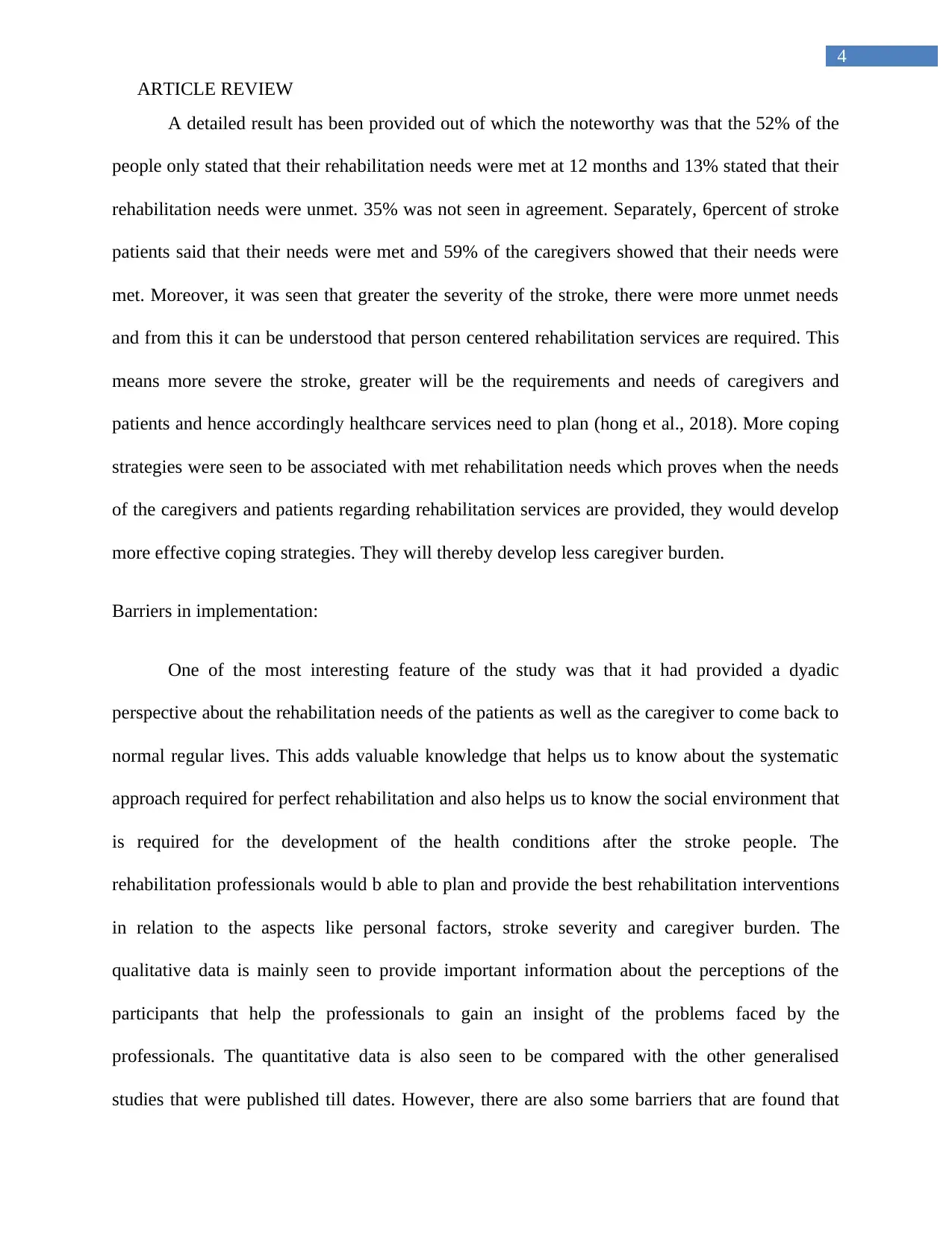
4
ARTICLE REVIEW
A detailed result has been provided out of which the noteworthy was that the 52% of the
people only stated that their rehabilitation needs were met at 12 months and 13% stated that their
rehabilitation needs were unmet. 35% was not seen in agreement. Separately, 6percent of stroke
patients said that their needs were met and 59% of the caregivers showed that their needs were
met. Moreover, it was seen that greater the severity of the stroke, there were more unmet needs
and from this it can be understood that person centered rehabilitation services are required. This
means more severe the stroke, greater will be the requirements and needs of caregivers and
patients and hence accordingly healthcare services need to plan (hong et al., 2018). More coping
strategies were seen to be associated with met rehabilitation needs which proves when the needs
of the caregivers and patients regarding rehabilitation services are provided, they would develop
more effective coping strategies. They will thereby develop less caregiver burden.
Barriers in implementation:
One of the most interesting feature of the study was that it had provided a dyadic
perspective about the rehabilitation needs of the patients as well as the caregiver to come back to
normal regular lives. This adds valuable knowledge that helps us to know about the systematic
approach required for perfect rehabilitation and also helps us to know the social environment that
is required for the development of the health conditions after the stroke people. The
rehabilitation professionals would b able to plan and provide the best rehabilitation interventions
in relation to the aspects like personal factors, stroke severity and caregiver burden. The
qualitative data is mainly seen to provide important information about the perceptions of the
participants that help the professionals to gain an insight of the problems faced by the
professionals. The quantitative data is also seen to be compared with the other generalised
studies that were published till dates. However, there are also some barriers that are found that
ARTICLE REVIEW
A detailed result has been provided out of which the noteworthy was that the 52% of the
people only stated that their rehabilitation needs were met at 12 months and 13% stated that their
rehabilitation needs were unmet. 35% was not seen in agreement. Separately, 6percent of stroke
patients said that their needs were met and 59% of the caregivers showed that their needs were
met. Moreover, it was seen that greater the severity of the stroke, there were more unmet needs
and from this it can be understood that person centered rehabilitation services are required. This
means more severe the stroke, greater will be the requirements and needs of caregivers and
patients and hence accordingly healthcare services need to plan (hong et al., 2018). More coping
strategies were seen to be associated with met rehabilitation needs which proves when the needs
of the caregivers and patients regarding rehabilitation services are provided, they would develop
more effective coping strategies. They will thereby develop less caregiver burden.
Barriers in implementation:
One of the most interesting feature of the study was that it had provided a dyadic
perspective about the rehabilitation needs of the patients as well as the caregiver to come back to
normal regular lives. This adds valuable knowledge that helps us to know about the systematic
approach required for perfect rehabilitation and also helps us to know the social environment that
is required for the development of the health conditions after the stroke people. The
rehabilitation professionals would b able to plan and provide the best rehabilitation interventions
in relation to the aspects like personal factors, stroke severity and caregiver burden. The
qualitative data is mainly seen to provide important information about the perceptions of the
participants that help the professionals to gain an insight of the problems faced by the
professionals. The quantitative data is also seen to be compared with the other generalised
studies that were published till dates. However, there are also some barriers that are found that
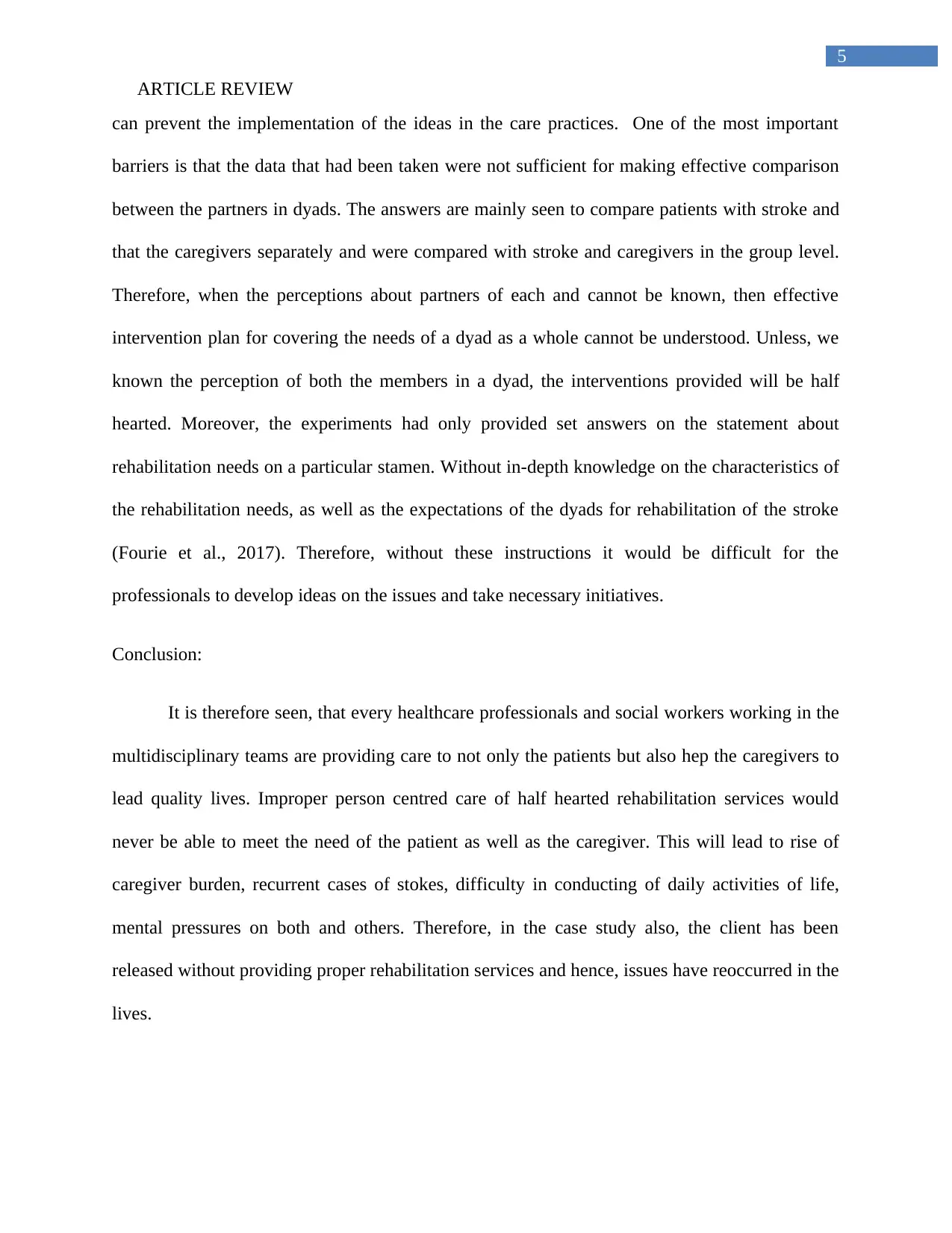
5
ARTICLE REVIEW
can prevent the implementation of the ideas in the care practices. One of the most important
barriers is that the data that had been taken were not sufficient for making effective comparison
between the partners in dyads. The answers are mainly seen to compare patients with stroke and
that the caregivers separately and were compared with stroke and caregivers in the group level.
Therefore, when the perceptions about partners of each and cannot be known, then effective
intervention plan for covering the needs of a dyad as a whole cannot be understood. Unless, we
known the perception of both the members in a dyad, the interventions provided will be half
hearted. Moreover, the experiments had only provided set answers on the statement about
rehabilitation needs on a particular stamen. Without in-depth knowledge on the characteristics of
the rehabilitation needs, as well as the expectations of the dyads for rehabilitation of the stroke
(Fourie et al., 2017). Therefore, without these instructions it would be difficult for the
professionals to develop ideas on the issues and take necessary initiatives.
Conclusion:
It is therefore seen, that every healthcare professionals and social workers working in the
multidisciplinary teams are providing care to not only the patients but also hep the caregivers to
lead quality lives. Improper person centred care of half hearted rehabilitation services would
never be able to meet the need of the patient as well as the caregiver. This will lead to rise of
caregiver burden, recurrent cases of stokes, difficulty in conducting of daily activities of life,
mental pressures on both and others. Therefore, in the case study also, the client has been
released without providing proper rehabilitation services and hence, issues have reoccurred in the
lives.
ARTICLE REVIEW
can prevent the implementation of the ideas in the care practices. One of the most important
barriers is that the data that had been taken were not sufficient for making effective comparison
between the partners in dyads. The answers are mainly seen to compare patients with stroke and
that the caregivers separately and were compared with stroke and caregivers in the group level.
Therefore, when the perceptions about partners of each and cannot be known, then effective
intervention plan for covering the needs of a dyad as a whole cannot be understood. Unless, we
known the perception of both the members in a dyad, the interventions provided will be half
hearted. Moreover, the experiments had only provided set answers on the statement about
rehabilitation needs on a particular stamen. Without in-depth knowledge on the characteristics of
the rehabilitation needs, as well as the expectations of the dyads for rehabilitation of the stroke
(Fourie et al., 2017). Therefore, without these instructions it would be difficult for the
professionals to develop ideas on the issues and take necessary initiatives.
Conclusion:
It is therefore seen, that every healthcare professionals and social workers working in the
multidisciplinary teams are providing care to not only the patients but also hep the caregivers to
lead quality lives. Improper person centred care of half hearted rehabilitation services would
never be able to meet the need of the patient as well as the caregiver. This will lead to rise of
caregiver burden, recurrent cases of stokes, difficulty in conducting of daily activities of life,
mental pressures on both and others. Therefore, in the case study also, the client has been
released without providing proper rehabilitation services and hence, issues have reoccurred in the
lives.
⊘ This is a preview!⊘
Do you want full access?
Subscribe today to unlock all pages.

Trusted by 1+ million students worldwide
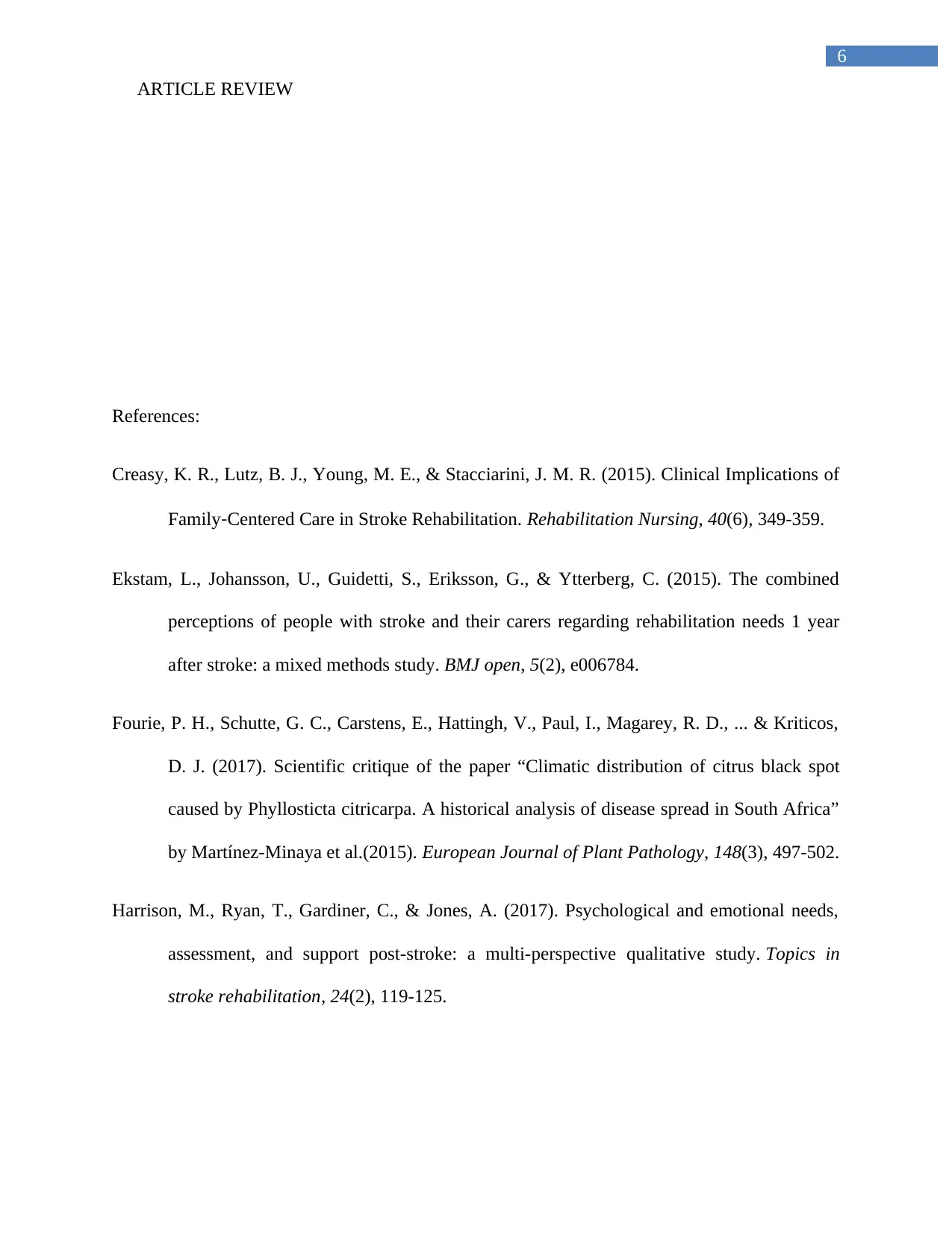
6
ARTICLE REVIEW
References:
Creasy, K. R., Lutz, B. J., Young, M. E., & Stacciarini, J. M. R. (2015). Clinical Implications of
Family‐Centered Care in Stroke Rehabilitation. Rehabilitation Nursing, 40(6), 349-359.
Ekstam, L., Johansson, U., Guidetti, S., Eriksson, G., & Ytterberg, C. (2015). The combined
perceptions of people with stroke and their carers regarding rehabilitation needs 1 year
after stroke: a mixed methods study. BMJ open, 5(2), e006784.
Fourie, P. H., Schutte, G. C., Carstens, E., Hattingh, V., Paul, I., Magarey, R. D., ... & Kriticos,
D. J. (2017). Scientific critique of the paper “Climatic distribution of citrus black spot
caused by Phyllosticta citricarpa. A historical analysis of disease spread in South Africa”
by Martínez-Minaya et al.(2015). European Journal of Plant Pathology, 148(3), 497-502.
Harrison, M., Ryan, T., Gardiner, C., & Jones, A. (2017). Psychological and emotional needs,
assessment, and support post-stroke: a multi-perspective qualitative study. Topics in
stroke rehabilitation, 24(2), 119-125.
ARTICLE REVIEW
References:
Creasy, K. R., Lutz, B. J., Young, M. E., & Stacciarini, J. M. R. (2015). Clinical Implications of
Family‐Centered Care in Stroke Rehabilitation. Rehabilitation Nursing, 40(6), 349-359.
Ekstam, L., Johansson, U., Guidetti, S., Eriksson, G., & Ytterberg, C. (2015). The combined
perceptions of people with stroke and their carers regarding rehabilitation needs 1 year
after stroke: a mixed methods study. BMJ open, 5(2), e006784.
Fourie, P. H., Schutte, G. C., Carstens, E., Hattingh, V., Paul, I., Magarey, R. D., ... & Kriticos,
D. J. (2017). Scientific critique of the paper “Climatic distribution of citrus black spot
caused by Phyllosticta citricarpa. A historical analysis of disease spread in South Africa”
by Martínez-Minaya et al.(2015). European Journal of Plant Pathology, 148(3), 497-502.
Harrison, M., Ryan, T., Gardiner, C., & Jones, A. (2017). Psychological and emotional needs,
assessment, and support post-stroke: a multi-perspective qualitative study. Topics in
stroke rehabilitation, 24(2), 119-125.
Paraphrase This Document
Need a fresh take? Get an instant paraphrase of this document with our AI Paraphraser
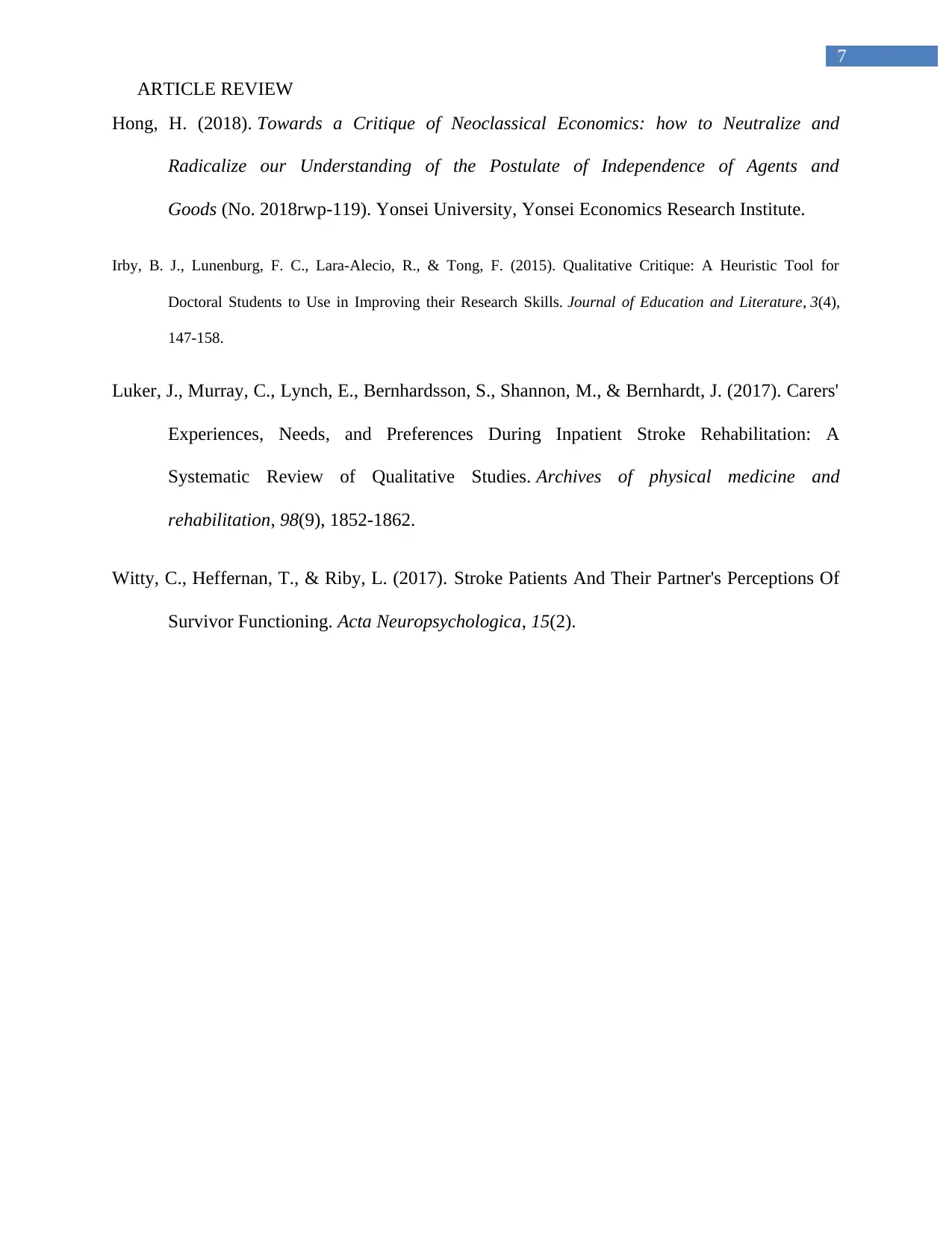
7
ARTICLE REVIEW
Hong, H. (2018). Towards a Critique of Neoclassical Economics: how to Neutralize and
Radicalize our Understanding of the Postulate of Independence of Agents and
Goods (No. 2018rwp-119). Yonsei University, Yonsei Economics Research Institute.
Irby, B. J., Lunenburg, F. C., Lara-Alecio, R., & Tong, F. (2015). Qualitative Critique: A Heuristic Tool for
Doctoral Students to Use in Improving their Research Skills. Journal of Education and Literature, 3(4),
147-158.
Luker, J., Murray, C., Lynch, E., Bernhardsson, S., Shannon, M., & Bernhardt, J. (2017). Carers'
Experiences, Needs, and Preferences During Inpatient Stroke Rehabilitation: A
Systematic Review of Qualitative Studies. Archives of physical medicine and
rehabilitation, 98(9), 1852-1862.
Witty, C., Heffernan, T., & Riby, L. (2017). Stroke Patients And Their Partner's Perceptions Of
Survivor Functioning. Acta Neuropsychologica, 15(2).
ARTICLE REVIEW
Hong, H. (2018). Towards a Critique of Neoclassical Economics: how to Neutralize and
Radicalize our Understanding of the Postulate of Independence of Agents and
Goods (No. 2018rwp-119). Yonsei University, Yonsei Economics Research Institute.
Irby, B. J., Lunenburg, F. C., Lara-Alecio, R., & Tong, F. (2015). Qualitative Critique: A Heuristic Tool for
Doctoral Students to Use in Improving their Research Skills. Journal of Education and Literature, 3(4),
147-158.
Luker, J., Murray, C., Lynch, E., Bernhardsson, S., Shannon, M., & Bernhardt, J. (2017). Carers'
Experiences, Needs, and Preferences During Inpatient Stroke Rehabilitation: A
Systematic Review of Qualitative Studies. Archives of physical medicine and
rehabilitation, 98(9), 1852-1862.
Witty, C., Heffernan, T., & Riby, L. (2017). Stroke Patients And Their Partner's Perceptions Of
Survivor Functioning. Acta Neuropsychologica, 15(2).
1 out of 8
Related Documents
Your All-in-One AI-Powered Toolkit for Academic Success.
+13062052269
info@desklib.com
Available 24*7 on WhatsApp / Email
![[object Object]](/_next/static/media/star-bottom.7253800d.svg)
Unlock your academic potential
Copyright © 2020–2025 A2Z Services. All Rights Reserved. Developed and managed by ZUCOL.




